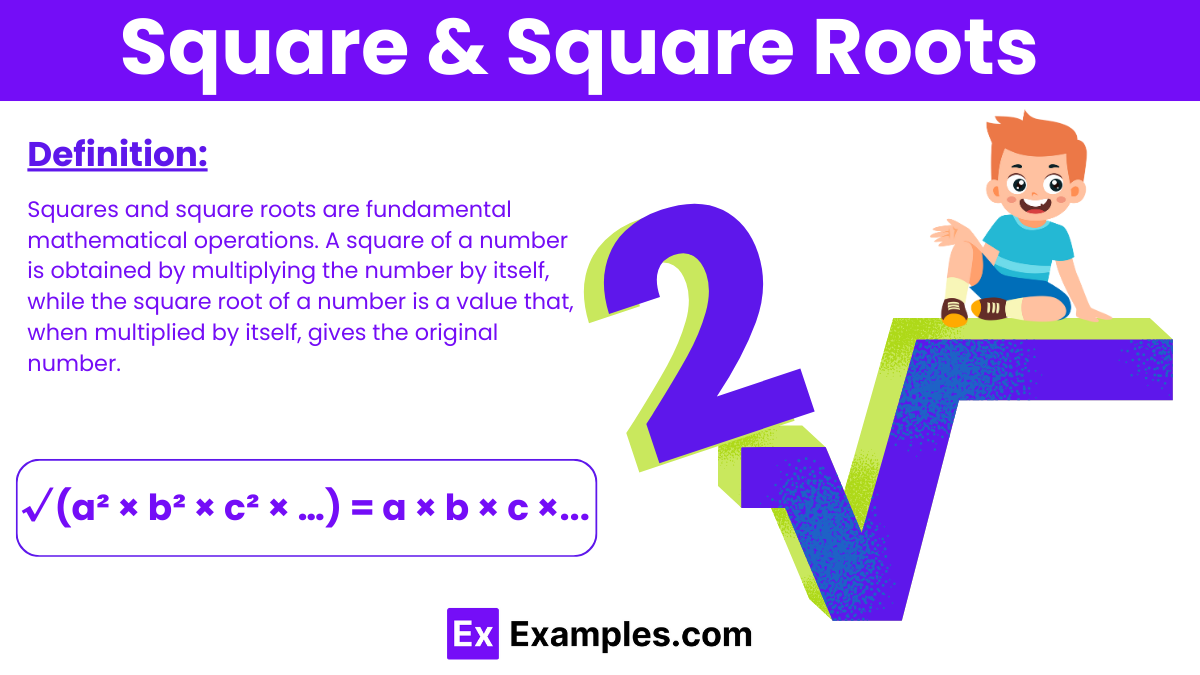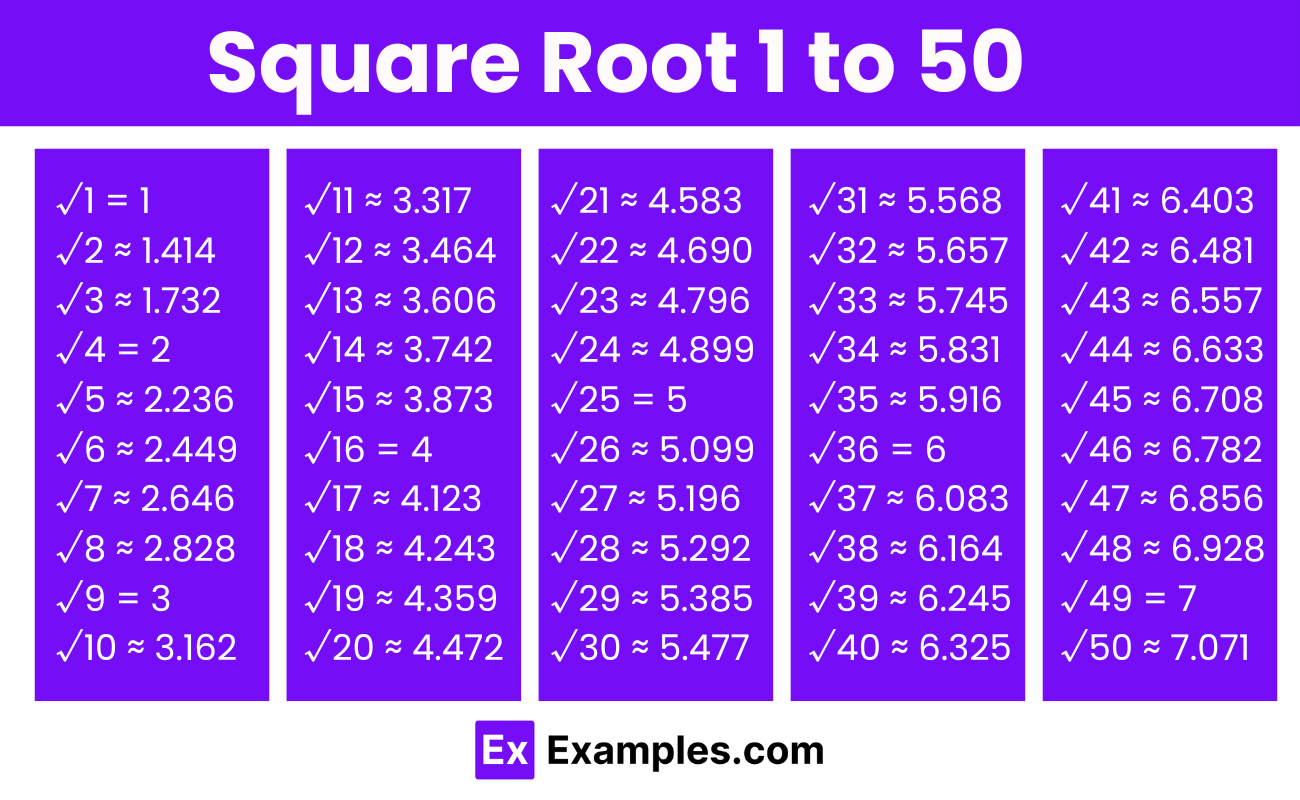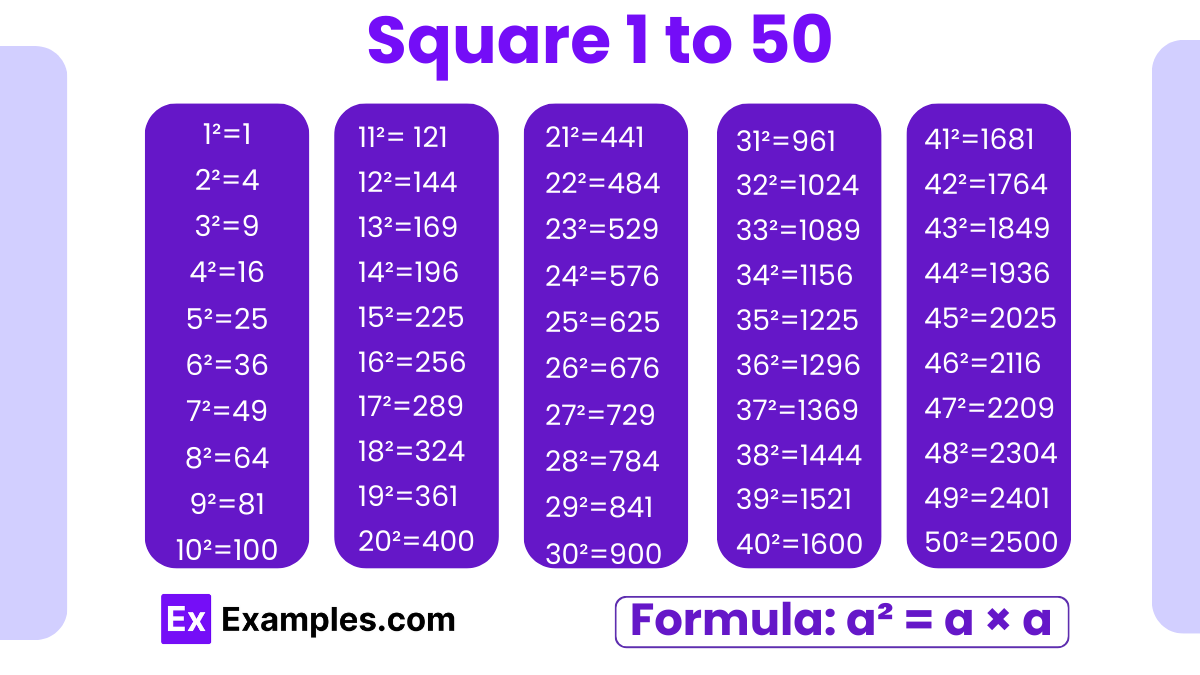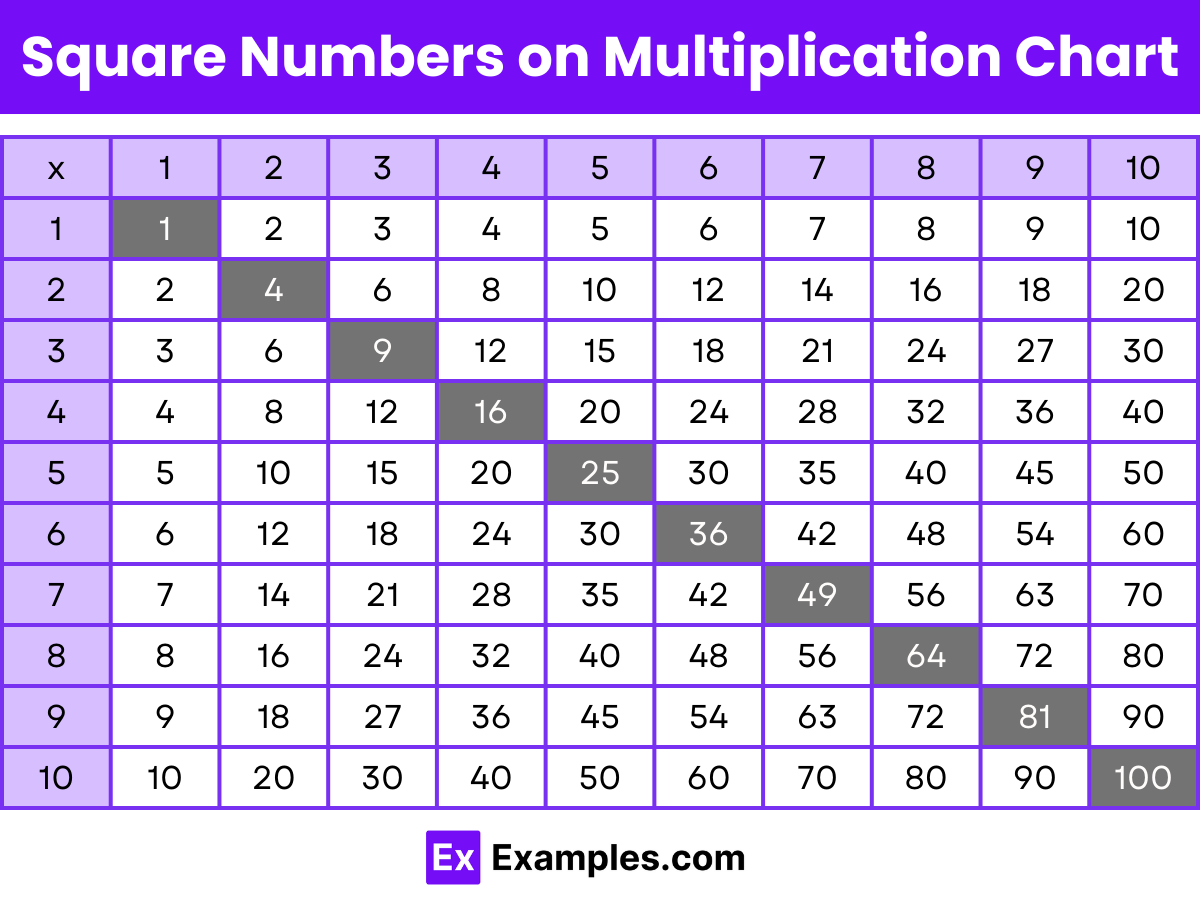What is the square of 15?
215
225
235
245

Squares and square roots are fundamental mathematical operations. A square of a number is obtained by multiplying the number by itself, while the square root of a number is a value that, when multiplied by itself, gives the original number. These concepts are crucial in various fields, including algebra, geometry, and physics.
Finding the square root of a number is to determine which number, when multiplied by itself, equals the original number. There are several methods to find square roots, each suitable for different kinds of numbers.
This method involves guessing the square root of a number and refining the guess based on its square.
To find √16, you might guess 4. Since 4² = 16, your guess is correct.

Prime factorization involves breaking down a number into its prime factors and identifying pairs of identical factors.
Formula: √(a² × b² × c² × …) = a × b × c × …
Examples: To find √144, note that 144 = 2² × 2² × 3². So, √144 = 2 × 2 × 3 = 12.
Example: Square Root of 16
This method is easy to understand and shows how square roots work, especially useful for learning with smaller, perfect square numbers.

The long division method is a systematic approach suitable for finding the square roots of both perfect and non-perfect squares.
Example: Finding √1225 involves dividing it into pairs (12 and 25), guessing the first digit of the root, subtracting its square, and continuing the process with what remains.
For most practical purposes, calculators provide the quickest and most accurate square roots.
Example: Inputting 144 and pressing √ yields 12.
Estimation is useful when an approximate square root is sufficient, especially if the number is not a perfect square.
Example: For √50, since 49 (7²) is below and 64 (8²) is above, estimate √50 to be between 7 and 8, closer to 7.
This method uses the curve of the equation y = x² to find square roots graphically.
Example: To find √49, draw a horizontal line at y = 49 across the curve y = x². The points of intersection at x = 7 (and x = -7) give the square roots.

| Number | Square Root | Number | Square Root | Number | Square Root |
|---|---|---|---|---|---|
| 1 | 1.000 | 18 | 4.243 | 35 | 5.916 |
| 2 | 1.414 | 19 | 4.359 | 36 | 6.000 |
| 3 | 1.732 | 20 | 4.472 | 37 | 6.083 |
| 4 | 2.000 | 21 | 4.583 | 38 | 6.164 |
| 5 | 2.236 | 22 | 4.690 | 39 | 6.245 |
| 6 | 2.449 | 23 | 4.796 | 40 | 6.325 |
| 7 | 2.646 | 24 | 4.899 | 41 | 6.403 |
| 8 | 2.828 | 25 | 5.000 | 42 | 6.481 |
| 9 | 3.000 | 26 | 5.099 | 43 | 6.557 |
| 10 | 3.162 | 27 | 5.196 | 44 | 6.633 |
| 11 | 3.317 | 28 | 5.292 | 45 | 6.708 |
| 12 | 3.464 | 29 | 5.385 | 46 | 6.782 |
| 13 | 3.606 | 30 | 5.477 | 47 | 6.856 |
| 14 | 3.742 | 31 | 5.568 | 48 | 6.928 |
| 15 | 3.873 | 32 | 5.657 | 49 | 7.000 |
| 16 | 4.000 | 33 | 5.745 | 50 | 7.071 |
| 17 | 4.123 | 34 | 5.831 |
The square root formula is used to find the square root of a number, which is the value that, when multiplied by itself, equals the original number. The formula is expressed as:
where:
For example, if x=9, then √9=3 because 3²=9.
This formula is fundamental in mathematics for solving problems involving square roots, including equations and understanding geometric properties.
The concept of the square root of a negative number introduces us to the realm of complex numbers. In traditional real number arithmetic, a square root of a negative number does not exist because no real number squared gives a negative result. However, in the complex number system, there is a special number denoted as “i,” known as the imaginary unit, which is defined by the property that i2=−1.
Let’s calculate the square root of √-16:
Perfect squares are the squares of whole numbers. The square root of a perfect square is always a whole number.
1² = 1 ⇔ √1 = 1
2² = 4 ⇔ √4 = 2
3² = 9 ⇔ √9 = 3
4² = 16 ⇔ √16 = 4
5² = 25 ⇔ √25 = 5
6² = 36 ⇔ √36 = 6
7² = 49 ⇔ √49 = 7
8² = 64 ⇔ √64 = 8
9² = 81 ⇔ √81 = 9
10² = 100 ⇔ √100 = 10
The square root of a decimal follows the same basic principle as finding the square root of whole numbers: it’s about finding a number that, when multiplied by itself, results in the original decimal. However, because the original number is a decimal, the square root will often be a decimal as well.
A square number is a number obtained when an integer is multiplied by itself.And It is also referred to as “a perfect square.”
Multiplying two positive integers together yields a positive result. And similarly, when two negative integers are multiplied, the outcome is also positive.
(+) × (+) = (+)
(-) × (-) = (+)
Examples of square numbers:
4 × 4 =16
(-5) × (-5) = 25
square numbers involves a simple process based on the definition of what a square number is. A square number, or a perfect square, is the product of an integer multiplied by itself. Here’s how you can find square numbers:

| Number – Square | Number – Square | Number – Square | Number – Square | Number – Square |
|---|---|---|---|---|
| 1²= 1 | 21²=441 | 41²=1681 | 61²=3721 | 81²=6561 |
| 2²=4 | 22²=484 | 42²=1764 | 62²=3844 | 82²=6724 |
| 3²=9 | 23²=529 | 43²=1849 | 63²=3969 | 83²=6889 |
| 4²=16 | 24²=576 | 44²=1936 | 64²=4096 | 84²=7056 |
| 5²=25 | 25²=625 | 45²=2025 | 65²=4225 | 85²=7225 |
| 6²=36 | 26²=676 | 46²=2116 | 66²=4356 | 86²=7396 |
| 7²=49 | 27²=729 | 47²=2209 | 67²=4489 | 87²=7569 |
| 8²=64 | 28²=784 | 48²=2304 | 68²=4624 | 88²=7744 |
| 9²=81 | 29²=841 | 49²=2401 | 69²=4761 | 89²=7921 |
| 10²=100 | 30²=900 | 50²=2500 | 70²=4900 | 90²=8100 |
| 11²=121 | 31²=961 | 51²=2601 | 71²=5041 | 91²=8281 |
| 12²=144 | 32²=1024 | 52²=2704 | 72²=5184 | 92²=8464 |
| 13²=169 | 33²=1089 | 53²=2809 | 73²=5329 | 93²=8649 |
| 14²=196 | 34²=1156 | 54²=2916 | 74²=5476 | 94²=8836 |
| 15²=225 | 35²=1225 | 55²=3025 | 75²=5625 | 95²=9025 |
| 16²=256 | 36²=1296 | 56²=3136 | 76²=5776 | 96²=9216 |
| 17²=289 | 37²=1369 | 57²=3249 | 77²=5929 | 97²=9409 |
| 18²=324 | 38²=1444 | 58²=3364 | 78²=6084 | 98²=9604 |
| 19²=361 | 39²=1521 | 59²=3481 | 79²=6241 | 99²=9801 |
| 20²=400 | 40²=1600 | 60²=3600 | 80²=6400 | 100²=10000 |
Two-digit square numbers are the squares of integers that result in values between 10 and 99.

| x | 1 | 2 | 3 | 4 | 5 | 6 | 7 | 8 | 9 | 10 |
| 1 | 1 | 2 | 3 | 4 | 5 | 6 | 7 | 8 | 9 | 10 |
| 2 | 2 | 4 | 6 | 8 | 10 | 12 | 14 | 16 | 18 | 20 |
| 3 | 3 | 6 | 9 | 12 | 15 | 18 | 21 | 24 | 27 | 30 |
| 4 | 4 | 8 | 12 | 16 | 20 | 24 | 28 | 32 | 36 | 40 |
| 5 | 5 | 10 | 15 | 20 | 25 | 30 | 35 | 40 | 45 | 50 |
| 6 | 6 | 12 | 18 | 24 | 30 | 36 | 42 | 48 | 54 | 60 |
| 7 | 7 | 14 | 21 | 28 | 35 | 42 | 49 | 56 | 63 | 70 |
| 8 | 8 | 16 | 24 | 32 | 40 | 48 | 56 | 64 | 72 | 80 |
| 9 | 9 | 18 | 27 | 36 | 45 | 54 | 63 | 72 | 81 | 90 |
| 10 | 10 | 20 | 30 | 40 | 50 | 60 | 70 | 80 | 90 | 100 |
To calculate the square root of a number, you can use methods like prime factorization, the long division method, or a calculator. This operation finds the number which, when squared, equals the original number.
Applying a square and a square root operation successively to a number generally returns the original number, provided the operations are executed in sequence on non-negative numbers.
To solve √50, simplify it by expressing 50 as 25 × 2. Since √25 is 5, √50 simplifies to 5√2, which is an exact and simplified form.
Yes, you can add √2 and √3, but they cannot be simplified to a single radical or whole number. The result is simply expressed as √2 + √3.
Yes, you can multiply √2 by √2. The result of this multiplication is 2, as the square root and the squaring operation cancel each other out.
Text prompt
Add Tone
10 Examples of Public speaking
20 Examples of Gas lighting
What is the square of 15?
215
225
235
245
What is the square root of 144?
10
11
12
13
Which number is a perfect square?
50
64
72
80
What is the square of 23?
529
533
543
553
What is the square root of 81?
7
8
9
10
What is the square of 18?
284
324
344
384
Which number is a perfect square?
90
100
110
120
What is the square root of 169?
11
12
13
14
What is the square of 11?
111
121
131
141
What is the square root of 256?
14
15
16
17
Before you leave, take our quick quiz to enhance your learning!

